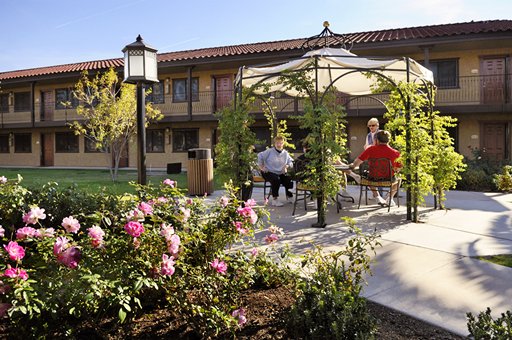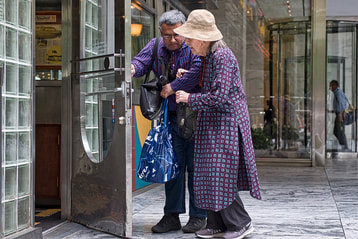|
If you're looking for an appropriate assisted senior living setting for a loved one chances are you have a lot of questions. Navigating the various aspects of senior living can be confusing. Each setting has its own unique benefits and no two are exactly alike. Here are a few of the most common types of senior living settings: Independent living Independent living communities are designed to enable healthy independent seniors to enjoy a low maintenance lifestyle filled with recreational and social activities among other seniors of a similar same age. These communities are generally restricted to people over the age of 55. Independent living communities do not offer health care services on campus. Assisted living Assisted living communities provide a combination of housing and healthcare services to seniors who may need addition support to managing typical activities of daily living. Assisted living facilities offer assistance with meals, bathing, medication and housekeeping. Additional features usually available include social gathering spaces, pools, exercise rooms, regular activities and outings. Some assisted living communities offer specialized services such as memory care for those who have dementia or Alzheimer’s. Adult Family Home An adult family home offers many of the benefits of assisted living such as help with medication, bathing and other activities of daily living but on a much smaller scale. These homes are generally run by independent operators caring for up to six residents at a time. Care is often provided within the care givers own home. This is a very intimate home like setting that offers much more individualized attention. Continuing Care Retirement Communities Continuing Care Retirement Communities (CCRC) are a type of retirement community that provides seniors with the full spectrum of options from independent living, assisted living and skilled nursing all on one campus. Continuing care retirement communities offer the ability to age in place and eliminate the need to move from one facility to another as health care needs progress. Skilled Nursing Often referred to as nursing homes, skilled nursing facilities provide 24 hour nursing care for those who need more direct daily care that is provided in a supportive living environment. Skilled nursing is often short term after a hospital stay but can be long term for those who need high levels of care. These facilities may also have specialized care such as physical therapy or occupational therapy. What is the difference between Home Care and Home Health? Sometimes the names are used interchangeably and that can be confusing but there are distinct differences. Basically Home Care is a non medical service and Home Health is a medically based service. So let's take a closer look: Home Health Home Health is paid for by Medicare, you have to have a doctors prescription and it's for a limited period of time. In order to qualify there will be an assessment that will be done to determine your needs. Home Health is often prescribed when somebody is leaving the hospital or a rehab facility and they need some additional care at home. It is limited so you may only get a few visits a week. This service does not fulfill the role of a primary caregiver. Home Health care can send out physical therapists, occupational therapists, speech therapists, wound care specialists etc. to help you acclimate back to home life. For example if someone had a stroke and their speech was affected Home Health care can send a speech therapist to the person in need of help instead of that person going to a facility for rehabilitation. Home Care Home Care can help with many of the day-to-day activities such as getting dressed, taking a shower, going to the grocery store, taking you to doctors appointments taking out the garbage and other little things around the house that may have become challenging. Home Care which is non medical and it is usually private pay so you pay out of your pocket. In some cases benefits like the veterans administration aid and attendance program or long term care insurance may help cover some of these costs. While Home Health and Home Care are two very different services there could be instances in which you need both of them together at the same time. For instance, physical therapy following a hip surgery may limit your ability to keep up with regular household chores. In this case Home Health would be there for the physical therapy and Home Care will be there to help with the other everyday tasks. Friends, family and spouses can only do so much and often have obligations of their own aside from acting as a care giver. Bringing in a little help can relieve a great deal of stress for everyone involved. Recognizing when a loved one may need assistance can play a huge roll in their quality of life and may make all the difference in the world when it comes to avoiding an emergency situation in the future. Here are a few things to look for when deciding if it is time to seek assistance.
1. The home becomes increasingly messy and basic maintenance goes ignored. It can be as simple as a sink full of dishes, stacks of unopened mail, an overgrown lawn or peeling paint. Aging can make it increasingly difficult to keep up regular household chores. Memory issues or dementia often contribute to the deferred maintenance and unpaid bills as the individual may not recognize or remember the need to take action. Unsanitary conditions can of course lead to additional health issues and clutter can easily increase the risk of falling. 2. Neglecting self care. Unkempt hair, body odor, bad breath and long/dirty fingernails are all obvious signs that an individual is not keeping up with their personal hygiene. Unless you are visiting regularly it may be more difficult to notice signs like not eating regularly, weight loss, not changing cloths and skipping medications. Physical limitations, dementia, social isolation and depression are just a few of the underlying factors that may contribute to these issues. Identifying these warning signs and talking with your loved one about their needs or struggles can make a huge difference in their quality of life. 3. Difficulty standing and walking or falling during everyday activities. Approximately one third of adults over the age of 65 will experience a fall. The medical costs associated with fall related injuries exceeds $31 billion annually and is likely to increase as our population ages. These falls are the number one cause of unintentional injury among the elderly and approximately 10% of these falls result in significant injury leading to health decline, additional falls or admission to a nursing facility. Fear of falling can lead to a lack of confidence and social isolation. These figures sourced from US National Library of Medicine, National Institutes of Health. 4. Social Isolation. Most people need a certain amount of social interaction to feel fulfilled in their lives. Many of the factors mentioned above may lead a person to withdraw from others but even those who may be perfectly capable of keeping up with all the normal activities of daily living may suffer from isolation or depression. Warning signs may include rarely leaving the house or withdrawing from social activities they formerly enjoyed. Recognizing and combating these issues can make all the difference in the quality of life for seniors. How to approach these needs can be as varied and nuanced as the individual themselves. With so many options available it can be difficult to know where to start. We at Lifestage focus on the four pillars of aging; Medical, Legal, financial and social. As with most things having a plan in place before it becomes an emergency will relieve a great deal of stress for everyone involved. |
Location |
Click to set custom HTML
|



 RSS Feed
RSS Feed
